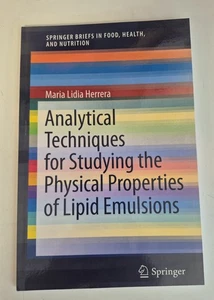Picture 1 of 4




Gallery
Picture 1 of 4




Have one to sell?
The Analytical Techniques For Studying The Physical Properties Of Lipid...
US $35.00
ApproximatelyRM 147.95
Condition:
Good
A book that has been read but is in good condition. Very minimal damage to the cover including scuff marks, but no holes or tears. The dust jacket for hard covers may not be included. Binding has minimal wear. The majority of pages are undamaged with minimal creasing or tearing, minimal pencil underlining of text, no highlighting of text, no writing in margins. No missing pages.
Oops! Looks like we're having trouble connecting to our server.
Refresh your browser window to try again.
Shipping:
US $5.22 (approx RM 22.06) USPS Media MailTM.
Located in: Chicago, Illinois, United States
Delivery:
Estimated between Wed, 27 Aug and Tue, 2 Sep to 94104
Returns:
No returns accepted.
Coverage:
Read item description or contact seller for details. See all detailsSee all details on coverage
(Not eligible for eBay purchase protection programmes)
Seller assumes all responsibility for this listing.
eBay item number:406049292894
Item specifics
- Condition
- ISBN
- 9781461432555
About this product
Product Identifiers
Publisher
Springer
ISBN-10
1461432553
ISBN-13
9781461432555
eBay Product ID (ePID)
112168659
Product Key Features
Number of Pages
VI, 66 Pages
Publication Name
Analytical Techniques for Studying the Physical Properties of Lipid Emulsions
Language
English
Subject
Food Science, Life Sciences / Biochemistry, General, Chemical & Biochemical, Chemistry / General
Publication Year
2012
Type
Textbook
Subject Area
Technology & Engineering, Science
Series
Springerbriefs in Food, Health, and Nutrition Ser.
Format
Trade Paperback
Dimensions
Item Weight
4.3 Oz
Item Length
9.3 in
Item Width
6.1 in
Additional Product Features
Intended Audience
Scholarly & Professional
Series Volume Number
3
Number of Volumes
1 vol.
Illustrated
Yes
Table Of Content
1. Introduction.- 2. Nano and Micro Food Emulsions.- 2.1. Methods of Formulation.- 2.2. Physical Chemical Properties.- 2.3. Structuring Food Emulsions.- 3. Methods for Stability Studies.- 3.1. Visual Observation.- 3.2. Rheological Methods.- 3.3. Ultrasound Profiling.- 3.4. Electroacoustic spectroscopy: Zeta Potential.- 3.5. Measurement of Surface Concentration.- 3.6. Microscropic Analysis.- 3.7. Nuclear Magnetic Resonance (NMR) Techniques.- 3.8. Optical Methods.
Synopsis
This book will review old and new methods to study emulsion stability and structure. Examples of emulsion-based foods include ice cream, yoghurt, and mayonnaise. The physicochemical properties of emulsions play an important role in food systems, as they directly contribute to the texture, sensory and nutritional properties of foods. One of the main properties is stability, which refers to the ability of an emulsion to resist physical changes over time. The development of an effective strategy to prevent undesirable changes in the properties of a particular food emulsion depends on the dominant physicochemical mechanism(s) responsible for the changes. In practice, two or more of these mechanisms may operate in concert. It is therefore important for food scientists to identify the relative importance of each mechanism, the relationship between them, and the factors that influence them, so that effective means of controlling the stability and physicochemical properties of emulsions can be established. Several techniques are used to study the physical behavior and structure of emulsions. Each technique has its advantages and disadvantages and provides different insights into the destabilization mechanisms. Among the oldest methods used to study emulsion stability is visual observation and small deformation rheometry. More recently, other techniques, such as ultrasound profiling, microscopy, droplet size distribution, and measurement of surface concentration to characterize adsorbed protein at the interface, have also been employed. Some of these techniques, such as droplet size distribution, involve some form of dilution. However, dilution disrupts some structures that play an important role in stability. The ability to study the stability of food emulsions in their undiluted form may reveal subtle nuances about their stability. Diffusing wave spectroscopy (DWS), laser scanning confocal microscopy (LSCM), nuclear magnetic resonance (NMR), and Turbiscan are among the more powerful, non-perturbing techniques used to characterized emulsions., 1. Introduction.- 2. Nano and Micro Food Emulsions.- 2.1. Methods of Formulation.- 2.2. Physical Chemical Properties.- 2.3. Structuring Food Emulsions.- 3. Methods for Stability Studies.- 3.1. Visual Observation.- 3.2. Rheological Methods.- 3.3. Ultrasound Profiling.- 3.4. Electroacoustic spectroscopy: Zeta Potential.- 3.5. Measurement of Surface Concentration.- 3.6. Microscropic Analysis.- 3.7. Nuclear Magnetic Resonance (NMR) Techniques.- 3.8. Optical Methods.
LC Classification Number
TX341-641
Item description from the seller
Seller feedback (102)
- n***c (232)- Feedback left by buyer.Past monthVerified purchaseexcellent vendeur.
- i***i (106)- Feedback left by buyer.Past monthVerified purchasePacked well to protect the book. No unpleasant surprises. All good.
- d***1 (198)- Feedback left by buyer.Past monthVerified purchaseIn great condition! Such a great deal for this book. 10/10
More to explore :
- Physics Study Study Guides Prep,
- Physics Study Workbooks Prep,
- Physics Study Paperbacks Prep,
- Physics Study Guides & Test Prep,
- Physics Study Guides & Test Prep in English,
- Physics Textbooks,
- Physics Textbook Textbooks,
- Physics Antiquarian & Collectible Books,
- Study Study Guides Prep,
- Language Study Education Study Guides & Test Prep

